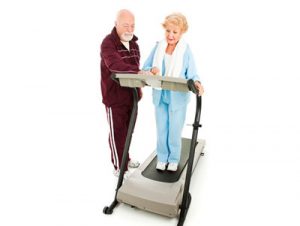 As we age, good balance can be a life saver.
As we age, good balance can be a life saver.
Falls among the elderly are a leading cause of debilitating injury (such as hip fractures) and a serious risk factor for premature death. By preventing balance problems and working to improve remaining ability, seniors can improve their quality of life and reduce crippling injuries.
There are a number of exercises that can help with improving balance. Before beginning an exercise program, however, one should first have a complete history and physical, including a review of medications, a musculoskeletal check for any abnormalities and blood tests to determine cholesterol and glucose levels. Additionally, any exercise program should build gradually to avoid burnout, boredom, or injuries.
Specific Exercises for Improving Balance
Knee Lifts: Attempt to lift the knee as high as the hip using a secure object to assist in maintaining balance in the beginning. As you grow stronger, decrease the tendency to lean on a support, and try holding the leg up for 3 seconds or longer. It is important to never close your eyes while performing standing stretch and relaxation activities due to difficulties maintaining balance.
Point and Flex: While sitting, point your toes and then flex them. Repeat with both feet. Toe Tapping: While sitting, tap your toes. Repeat with both feet.
Sit-to-Stand: When necessary, use a chair for support when standing and again when returning to a sitting position. Try to gradually decrease use of the arms as the legs get stronger.
Calf Muscle Strengthener: While holding onto a wall, chair or the kitchen sink, repeatedly raise yourself up and down on tiptoes. As your strength improves, go higher up on your toes and eventually try it on one foot at a time.
Shin Muscle Strengthener: Lean your back against a wall with your heels placed seven to eight inches away from the wall. Lift the toes of both feet off the ground as high as possible.
One-legged Stand: Hold onto a secure object during balance training, such as a sturdy chair. Lift one leg off the ground and try to maintain balance on the standing leg.
Hip/Thigh Muscle Strengthener: Take extra trips up and down the stairs. Hold onto the banister with one hand and press the other hand against the wall for safety. If you’re wary of stairs, you can strengthen the same muscles by getting up out of a chair repeatedly. Grip the arms of the chair if you need to, but you’ll get more benefit from the exercise if you don’t push with your hands.
Pelvis Exercise: When walking, if the pelvis does not shift far enough, the older adult’s foot will swing too low, causing a decreased height in step, which can cause tripping and falling. Exercises that target the pelvis may be beneficial. Using a chair for support, pretend that you are trying to keep a hula hoop around your waist.
Walking Check-in: In addition to lower step height, many older adults develop a shorter step length. Walking forward, backward, and sideways in front of a mirror will encourage the older adult to check posture, length of stride, and walking efficiency. Holding a balance bar, side-step right along the length of the bar and then repeat to the left.
To learn more about how to help senior loved ones stay safe, healthy, and happy at home, contact the home care experts at Live Free Home Health Care.
Source: The American Senior Fitness Association and the Ohio State University Extension

 As we age, good balance can be a life saver.
As we age, good balance can be a life saver.